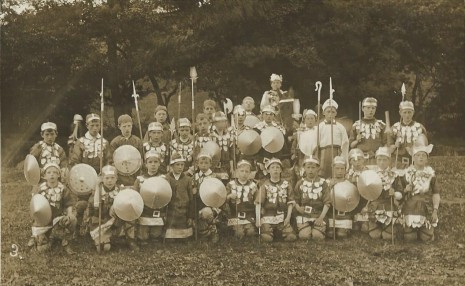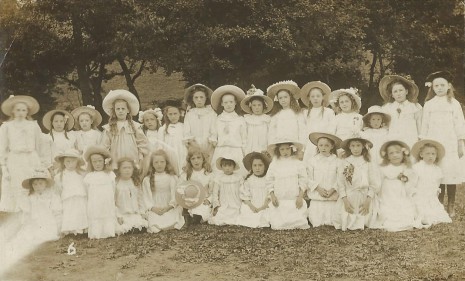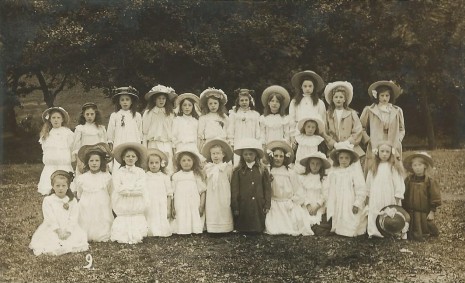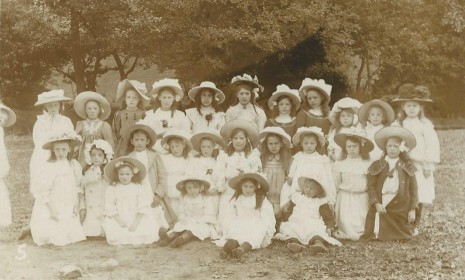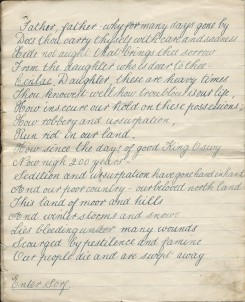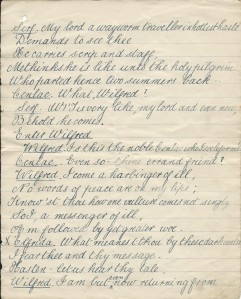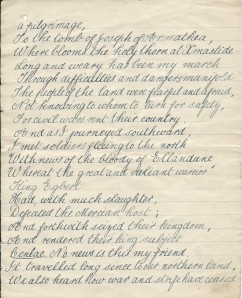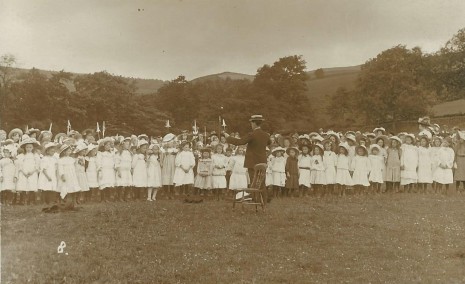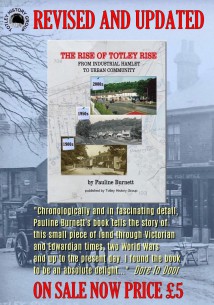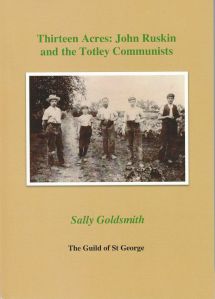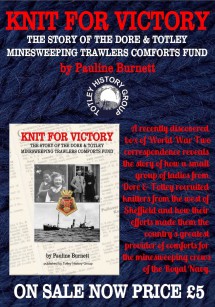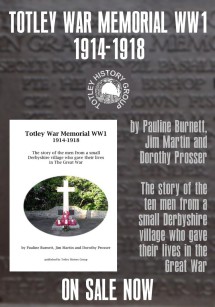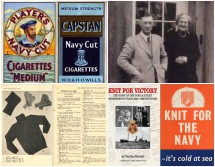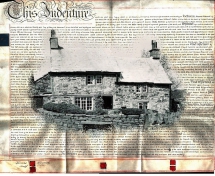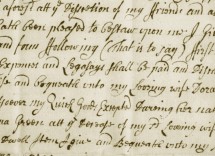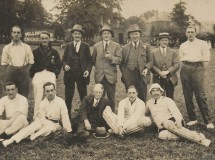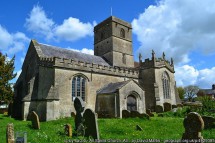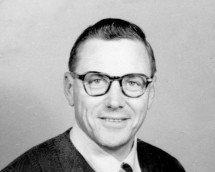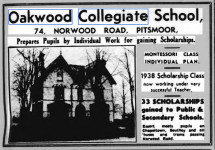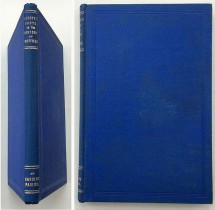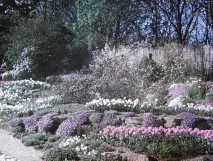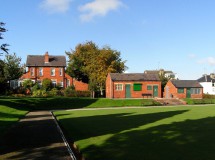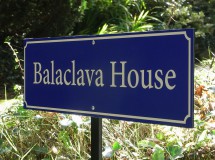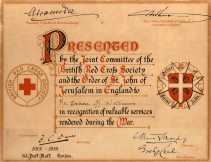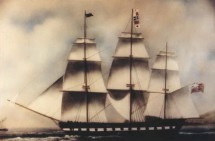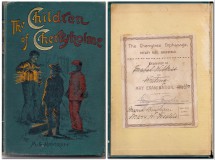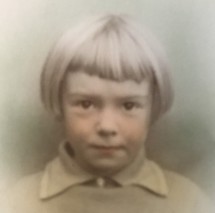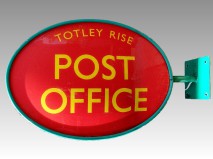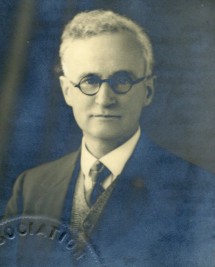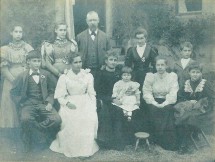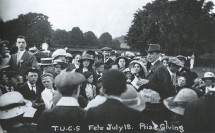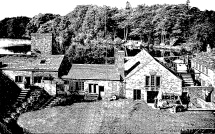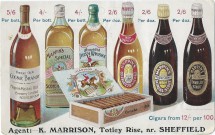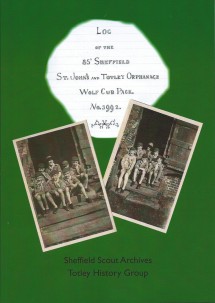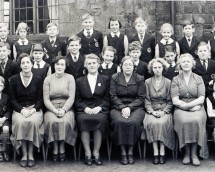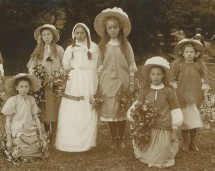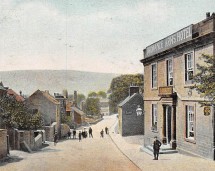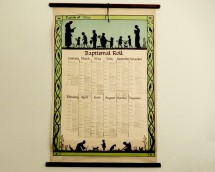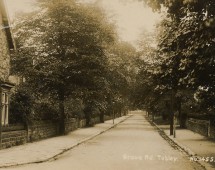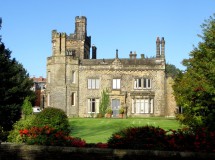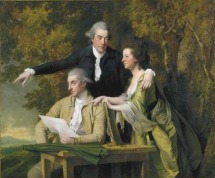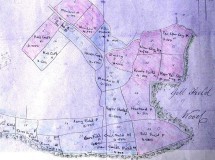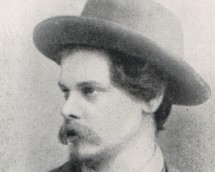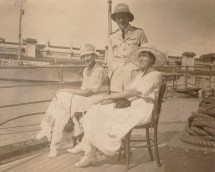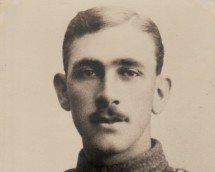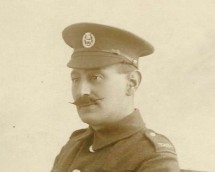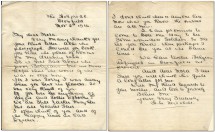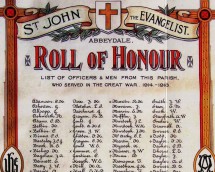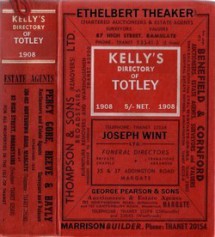School Pageant, 1909
These photographs and the script below were given to Totley All Saints School by Joan Grocutt in 2006. They had belonged to her aunt, Elsie Crookes (b. 3 May 1896), who lived at Rolling Mill Cottages in the 1901 census and who attended the school between 2 July 1901 and 7 May 1909. Elsie performed the part of Lady Elfrida, the daughter of Cenlac, the Thane of Dore, in the pageant. The newspaper articles below tell the full story of the event which took place near Avenue Farm on Thursday, 22nd July 1909.
Saturday 10 July 1909 Sheffield Daily Independent (page 9)
Forthcoming Pageant at Dore.
Arrangements are well in hand for the historical pageant which is to take place at Dore on the 22nd inst. The pageant, which is under the patronage of Mr. James Oakes,
chairman of the Derby Education Committee, and Mr. G. H. Grindrod, H.M.I., will be held in a field beyond Avenue Farm, a place well adapted for the purpose, and as the Vicar (the Rev. Wm. R. Gibson)
says, "amidst most romantic scenery at the foot of the moors." The story of the pageant will carry one back to the year 827, when the peaceful inhabitants living in the moorland of Dore, tending
their cattle and ploughing their land, had alarming news brought to their simple homesteads by a way-worn traveller, a holy pilgrim. This traveller was returning from the south of England, where King
Egbert, the valiant warrior, was laying low all that tried to oppose him, and was on his way northwards to bring the Northumbrians under his rule. Eanred, the King of Northumbria, summons a
Parliament of his most trusty followers, thanes from all parts of his vast kingdom. There is a representative of Durham, of Berwick, of York, of Edinburgh, and in the immediate neighbourhood, from
Bolsterstone and Dore. These all meet at Dore, as being the most southerly point of the kingdom, to discuss with Egbert the situation, and to offer terms of submission, and so prevent, if possible,
further war and bloodshed. Nearly all the children in both the schools of Dore and Totley will take part.
Thursday 15th July 1909 Sheffield Daily Telegraph (page 1)
Dore and Totley Historical Pageant
The Children of Dore and Totley Schools will celebrate by a Pageant the Union of England under Egbert, which took place at Dore, A.D. 827, thus bringing to a close the
Heptarchy, in a Field Close To The Avenue Farm, on Thursday Afternoon, July 22nd to commence at 3.30 o'clock. Carriages may be had at Dore Station. Admission to the Field, Sixpence Each.
Friday 16th July 1909 Belper News and Derbyshire Telephone (page 2)
Items of Interest
Mrs Milner, of Totley Hall, has prepared an interesting little book for the Dore and Totley pageant on July 22nd. Of course, it does not pretend to be so ambitious as the
great pageant at York, but we venture to think that few villages of the size of Dore would be able to anything on so notable a scale. The ladies are now all exceedingly busy preparing the dresses.
They are no doubt glad that the pageant will illustrate history in the year 827, when fashions were not so formidable as they are to-day. There are, however, two Kings and an Archbishop among the
characters to be presented, as well as courtiers and soldiers, so that the scene ought to be a very striking one. Dore, with its beautiful grassy slopes and lovely woods, will form a delightful
setting for such a display, which will, no doubt, attract big crowds. The scene is to be presented is the marching of King Egbert will his army to Dore to meet the Northumbrians. It will be shown how
and why they "buried the hatchet."
Saturday 17th July 1909 Sheffield Independent (page 12)
Dore and Totley Historical Pageant
The Children of Dore and Totley Schools will celebrate by a Pageant the Union of England under Egbert, which took place at Dore, A.D. 827, thus bringing to a close the
Heptarchy, in a Field close to Avenue Farm, Dore, on Thursday Afternoon, July 22nd to commence at about 3.30. There will be Morris Dancing, Chorus Singing, and the Band of the Boy's Brigade.
Carriages may be had at Dore Station. Admission to Field 6d; Enclosure 2s. and 1s.
Thursday 22nd July 1909 Sheffield Independent (page 1)
The Dore and Totley Historical Pageant
The Children of Dore and Totley Schools will celebrate by a Pageant the Union of England under Egbert, which took place at Dore, A.D. 827, thus bringing to a close the
Heptarchy, in a Field close to Avenue Farm, Dore, THIS (THURSDAY) AFTERNOON, July 22nd to commence at about 3.30. A second performance will take place at 5.30. There will be Morris
Dancing, Chorus Singing, and the Band of the Boy's Brigade. Carriages may be had at Dore Station. Admission to Field 6d; Enclosure 2s. and 1s.
Friday 23rd July 1909 Sheffield Daily Independent (page 10)
Dore Pageant
Charming Performance by Village Children
Local History Re-enacted
Pageantitis has penetrated even to the charming little villages of Dore and Totley, and yesterday the public were given an opportunity of witnessing the result. Dore, of
course, has some history to boast of, for it was there in A.D. 827 that the Northumbrians offered King Ecgbert "obedience and concord," and this brought about the union of England and the termination
of the Heptarchy. This important episode in English history was quite sufficient groundwork upon which to build a pageant, and it was admirably done by Mrs. Milner, of Totley House, assisted by a
committee of ladies. The actors were about 250 children, of the Dore and Totley schools, and the proceeds from the two performances will assist the funds of those schools, particularly that of Dore,
which at the present time is undergoing structural alterations.
The spot chosen for the performances, a field close to Avenue Farm, was an ideal one. The audience were accommodated on ground sloping steeply to the level portion of
the field, which was backed with trees, forming admirable cover for the actors. The text of the play, written specially by Mrs. Milner, represents Cenlac, Thane of Dore, conversing with his daughter
upon the troublous nature of the times and telling her how:-
Our poor country,
Our beloved north land,
This land of moor and hills,
And winter storms and snows,
Lies bleeding under many wounds.
A traveller enters bearing news of the advance of the conquering Egbert, and a moment later comes a summons to Cenlac to attend a Parliament under Eanred, King of Northumbria, to decide for peace or war. The Parliament is held, and though the King is counselled to submit, he tries to rouse the Thanes to resistance. The Archbishop of York then uses his influence with him on the side of peace bidding him despise earthly glories so that he may win a heavenly crown, and the King submits. Then Egbert enters with his soldiers, and demands of Eanred whether there shall be submission or war. Eanred vows obedience and submission, and lays his crown at Egbert's feet, upon which Egbert promises his protection to the country and Earnred take again his crown.
An Effective Banner
The performance commenced with the entry of the whole of the actors, headed by a Boys' Brigade band from Sheffield under Capt. Cole, and when they had reached the stage ground the choir sang "Hail
smiling morn," and a patriotic song, while aloft was held a banner on which was written "True patriotism is not only love of the soil. It is love of the past; it is reverence for generations that
have gone before." Though, of course, with the children there was no fine acting, the little folk did remarkably well and one noticed some decidedly good points about the performance, especially the
dressing which was capital. King Egbert was quite a striking figure mounted on his cloth-decked horse, while soldiers, foresters, the Archbishop, and others added much to the picturesqueness of the
scene. The articulation of the actors, particularly King Eanred, was very clear, and some of the scenes were very effectively arranged, notably that of the Parliament. In this the King, having
arrived with his train, seats himself on the sylvan throne, and then the various notabilities enter, announced by the herald, and arrange themselves about the King who, however, kneels to the
Archbishop. Another good scene was the entry of Egbert, his troops singing "See the conquering hero," and the submission of the King of Northumbria. During the performance there was some pretty
Morris dancing by little girls and singing by the chorus, and the whole concluded with the National Anthem and a grand march past.
The committee assisting Mrs Milner were the following: Miss Crosbie, Miss Taylor, Mrs. J. Cooper, Mrs. T. Cooper, Mrs. Joseph Cooper (hon. secretary), Mrs. Anderson, Mrs. Webster, Miss Webster, Mrs. Kirfoot, Mrs. Gibson, Mrs. Strange, Mrs. Newton Coombe, Miss Hancock, Mrs. and Miss Andrews, Mrs. Porrett, Miss Mary Cooper, Mrs. Parkes, Mrs. Foulstone, Mrs. Jackson, Miss Moss, Mrs. Armitage, Miss Porrett (treasurer) and Mr. Parsons.
Friday 30th July 1909 Belper News and Derbyshire Telephone (page 2)
Picturesque School Pageant.
Lesson To Copy
Tradition has it that far back in the dim past, the green and tranquil valley of Dore was the scene of an historic meeting. It is chronicled in in certain musty records
that i the year 827, after subduing the Kingdom of the Mercians, King Egbert led an army to Dore against the Northumbrians. The northerners, however, offered submission to Egbert, who signed the
treaty which put and end to the Heptarchy and united England.
The interesting episode which links Dore in such a picturesque manner with olden times was re-enacted on Thursday, in one of the sylvan dales near Dore, and not far distant from the spot known as "King's field," where it is supposed that Egbert actually received the promise of allegiance from the sturdy sons of Northumbria.
It was, in fact, a historic pageant in miniature, the actors in which were some 200 children from the Dore and Totley Schools. Remote as it is from the world, the little village of Dore has caught the pageantry fever. It is proud of its historical associations, but it was not only to remind people of these that the performance was held. A higher motive actuated the organisers and that was to make the young folks of Dore patriotic.
"True patriotism is not only love of the soil. It is love of the past, and reverence for the generations that have gone before."
These words were blazoned forth on a banner held aloft before the commencement of the performance, and they gave a deeper meaning to the spectacle that followed.
A more beautiful setting for the pageant could not be imagined. The scenes were enacted in a natural theatre, under the leafy shelter of flourishing trees, with the noble hills rising in the background. The silence of the restful little glade was on Wednesday broken by the bold notes of bugles and drums, alternating with the sweeter sounds of children's voices singing in unison, whilst its accustomed peaceful aspect was changed into a picture of colour and movement.
A large crowd of spectators had taken up their position on the grassy slope overlooking the small arena by the time the gay and many-hued procession marched into the field, headed by the band of the Boys' Brigade. The children were grouped on one side of the arena, and presently their silver voices were raised in the song, "Hail, smiling morn," which was followed by the singing of "What of the Bow."
The historic episode opened with a pastoral scene which was charming in its simplicity. As the last notes of the chorus died away, a wild, picturesque figure, dressed in an animal's skin, wandered on to the grassy stage. It was Cutha, a herd man, who concealed himself behind a thicket to listen to the song of Judith, a pretty little cowherd who appeared from the shelter of the trees. Animation was introduced into the scene by the arrival of a party of green-clad foresters, who passed through cheerily singing a gay carol of the woodlands, and there was an element of fun when the sturdy Cutha engaged in a brisk duel with staffs with an uncouth serf. The joyousness and freedom of the forest glade was prettily suggested by some Morris-dancers who tripped into view waving their wreaths of flowers in the breeze.
Cenlac, the Thane of Dore, in an interview with his daughter Lady Elfrida, a picture in white, spoke sadly of troublous times, and a moment later there came a harbinger of ill in "Wilfred," a pilgrim, who warned Cenlac of the approach of Egbert.
A splendid boy, armed with shield and spear, appeared. He was a soldier who summoned Cenlac to a council called by the King of Northumbria. The scene closed with a song by Elfrida, "Britons strike home," and the chorus sang the hymn "Let all our brethren."
Extremely pretty was the scene showing the entry of King Eanred, of Northumbria, and his gorgeously attired train. The council scene was quite impressive, and the juvenile actors realised the dignity of the occasion. The King very majestically assumed his seat on a throne of huge rough stones, and received the homage of his nobles, ealdermen, and thanes, who each made a low and graceful obeisance as they passed before the throne.
"Leofric, Archbishop of York," solemnly announced a handsome young herald, and there approached from the far end of the arena a small ecclesiastical procession, with cross held aloft before the Archbishop, who was in full canonicals, and was accompanied by a retinue of sombre-gowned monks.
The King descended from his throne and knelt down to receive the blessing of the Archbishop - a picturesque scene which was enacted with true artistic perception by the young folks. While the King sat in solemn conference with his counsellors, shrill voices were heard in the woods in the distant chanting "See the conquering hero comes." A moment later there emerged from the woods a glittering cavalcade. It was a brave band of soldiery, in front of whom, sitting astride a pony with purple and silver trappings, was the bold figure of King Egbert.
A dramatic incident followed. When the invading monarch dismounted the Northumbrian King knelt before him in an attitude of submission, and laid his crown at his feet. Egbert made a magnanimous speech, and lusty shouts of "Waes hael, Bretwalda" closed the scene.
An imposing spectacle was formed as the soldiers, foresters, monks, Morris-dancers, and all the picturesque-clad actors in the pageant formed into procession and marched round the arena, the delighted spectators loudly applauding the young processionists as they passed.
The children had been admirably trained and the teachers are to be congratulated upon the fact that the performance was not marred by a single hitch. Many of the children seemed to possess some histrionic intuition, and each of them pronounced their lines with a boldness of utterance which is unusual in juveniles.
The principal characters were sustained by the following:- Harold Bishop (Egbert), Joseph William Flint (Eanred), Robert Cracknell (Leofric), Cyril Gardner (Cenlac), Noel Fletcher (Morcar), Bernard Turner (Wilfred), Fred Andrews (Cutha), Ernest Bennett (Alfred), Elsie Crookes (Lady Elfrida), Dora Hodkin (Judith), Tom Bradley (serf), Frank Flint (herald), Bernard Wolsterholme (soldier), Willis Farnsworth (Cenwolf), Frank Taylor (Siward), Clifford Whittle (Ina) and Joseph Gill (Cuthlac). The Morris-dancers were Florence Marshall, Annie Ramsell, Ethel Stratford, Dora Hodkins, Grace Johnson and Lucy Ward, and they were coached by Miss Porritt and Miss Cooper.
Mr Bone (headmaster of Dore) and Mr Wood (headmaster of Totley) received valuable assistance in the training of the children from the Misses Hodkin, Scutterfitt, Marsden, Lee, Andrews, and Crooks, members of the teaching staffs. The authoress of the words of the pageant, which were gracefully written, is Miss Milner, the daughter of Mr and Mrs W.A. Milner, who were amongst the spectators, and took a keen interest in the proceedings.
The whole of the picturesque costumes, which were quite of the period, were made by the Ladies' Committee, consisting of the following: Mrs W.A. Milner, Miss Crobie, Miss Taylor, Mrs John Cooper, Mrs Anderson, Mrs and Miss Webster, Mrs Kerfoot, Mrs W.R. Gibson, Mrs Strange, Mrs Newton Combe, Mrs Armitage, Miss Hancock, Mrs Andrews, Miss Andrews, Miss Poritt (treasurer), Miss Mary Cooper, Miss Sparkes, Mrs Foulstone, Mrs Jackson, and Miss Moss. The secretarial duties were admirably carried out by Mrs Joseph Cooper. The proceeds are to be devoted to the Dore and Totley Schools.
Script (Remnants of)
Page 1.
[Elfrida].
Father, father - why for many days gone by
Does thou carry thyself with care and sadness
Hide not aught that brings thee sorrow
From the daughter who is dear to thee -
Cenlac.
Daughter, these are heavy times
Thou knowest well how troublous is our life,
How insecure our hold on these possessions
How robbery and usurpation,
Run riot in our land.
How since the days of good King Oswy
Now nigh 200 years -
Sedition and usurpation have gone hand in hand
And our poor country - our beloved north land
This land of moor and hills
And winter storms and snows
Lies bleeding under many wounds
Scourged by pestilence and famine
Our people die and are swept away
Enter Serf
Page 2.
Serf.
My lord a wayworn traveller in hottest haste
Demands to see thee
He carries scrip and staff,
Methinks he is like unto the holy pilgrim
Who parted hence two summers back -
Cenlac.
What, Wilfred?
Serf.
Tis very like, my lord and even now
Behold he comes.
Enter Wilfred
Wilfred.
Is this the noble Cenlac I see before me?
Cenlac.
Even so - thine errand friend?
Wilfred.
I come a harbinger of ill,
No words of peace are on my lips;
Know'st thou how one vulture comes not singly
So I, a messenger of ill,
Am followed by yet another woe.
Elfrida.
What means thee by these dark words?
I fear thee and thy message.
Hasten - let us hear thy tale.
Wilfred.
I am but even now returning from
Page 3.
A pilgrimage,
To the tomb of Joseph of Arimathea,
Where blooms the holy thorn at Xmastide
Long and weary has been my march
Through difficulties and dangers manifold
The people of the land were fearful and afraid,
Not knowing to whom to turn for safety,
For civil wars rent their country.
And as I journeyed southward,
I met soldiers fleeing to the north
With news of the bloody of Ellandune,
Whereat the great and valiant warrior
King Egbert
Had, with much slaughter,
Defeated the Mercian host;
And forthwith seized their kingdom,
And rendered their king subject.
Cenlac.
No news is this my friend.
It travelled long since to our northern land,
We also heard how war and strife have ceased
Page 4.
"Foresters sound the cheerful horn"
Cutha.
By my halidome
An unmannerly knave
Would I could lay my trusty staff
Across his churlish shoulders!
Enter Elfrida
Elfrida.
What! Not away yet?
Methinks thou dallied long
And thy task will not be done
E'er the sun sinks below the horizon.
Begone - and seek thy master's herd -
and thee Cutha - Hinder not thy fellow servant
If thy task providest not occupation enough,
For one pair of hands
Delay not those to whom
Time flies too fast.
Lo, my father comes,
With step both sad and slow!
What means this heavy aspect?
Enter Cenlac
Page 5.
In those more favoured lands
An era of peace having dawned
Under the rule of their great conqueror
Wilfred.
Peace, and listen further.
My message is not ended,
It is now a week gone by
Since I wearied with my journey
Rested at the house of Cenwolf
There heard I from his vassals that
there [their] master
Had gone northward, summoned by our king Eanred
To Witengemot of our chiefs earldermen and
bishops,
They are to gather hard by,
Where the river Sheaf rises in the hills
For rumour says the great King Egbert
Marches hither to lay low our native land.
Bugle Call.
Cenlac.
Hark, what other messenger of ill
draws nigh
Page 6.
Enter soldier
Soldier.
Is this my Lord Cenlac, Thane of Dore?
Cenlac
I am he.
Soldier.
My errand is to thee
I come - a messenger
From King Eanred
A bearer of this royal summons
Gives letter
Cenlac reads
Elfrida.
Father, father, tell me what thou readest
My heart misgives me
I fear the message -
Cenlac.
Daughter, the pilgrims [pilgrim's] words are true
King Egbert and his army are at hand -
This summons calls me to a parliament
Whereat our wisest and greatest chieftains
With King Eanred at their head
Decide for peace or war
I go - farewell, Elfrida
Page 7.
Elfrida.
Oh weighty decision - I summon
all my courage - here to await thy return
Exit Cenlac
Elfrida.
Tell me pilgrim, hast thou seen this
awe inspiring conqueror?
This great King Egbert
At whose feet lie all the kingdom of the land
Wilfred.
I saw him not, oh lady fair
But heard many things concerning him
And of all the words I heard,
There was not one of ill but only good
Elfrida.
Come hither to the house
And tell me more
When thou art fed and rested -
Wilfred.
Gentle lady my thanks and homage
Footsore and weary am I with wayfaring so far
Elfrida.
Chorus - Britons, Strike Home. [A British patriotic song written by Henry Purcell in 1695]
This fragment of the script illustrates an error pointed out by John Dunstan in his book Dore Old School in Records and Recollections (2006). The pageant was written in the mistaken belief that Dore in 827 A.D. was at the southernmost point of the Northumbrian kingdom whereas, in fact, it was on Mercian land newly conquered by King Egbert of Wessex.
We are very grateful to Karole Sargent, the headteacher at Totley All Saints School, for allowing us access to an archive of school material including this historical pageant.
If you have any more photographs or information about the pageant we would love to hear from you. We are especially keen to trace a copy of the full script and to clarify whether it was Mrs. Sarah Milner or her daughter Marjorie Elsie Milner who wrote the pageant. You can contact us at our usual email address of: contactus@totleyhistorygroup.org.uk
Bernard Turner, who played Wilfred in the pageant, was the youngest of the ten soldiers from Totley who lost their lives during World War 1. Their stories are told in our publication Totley War Memorial WW1 1914-18.
Search Our Website Here
September
October
November
Unless stated otherwise our meetings are held in Totley Library on the 4th Wednesday of each month at 7.30pm.
Pauline Burnett's book The Rise of Totley Rise has been revised and updated. It tells the story of this small piece of land from 1875 when there was only a rolling mill and chemical yard alongside the river a mile from Totley, through Victorian and Edwardian times, two world wars and up to the present day. It has 94 pages including a useful index and many illustrations from private collections. The book is available now from Totley Rise Post Office priced at £5, or through our website when an additional charge will be made to cover packing and postage.
A few copies are still available of Sally Goldsmith's book Thirteen Acres: John Ruskin and the Totley Communists. Totley was the site of a utopian scheme funded by art critic and social reformer John Ruskin. In 1877 he bought 13-acre St. George’s Farm so that nine Sheffield working men and their families could work the land and, to keep themselves busy, make boots and shoes. Sally tells an engaging story from our history with a quirky cast of characters including Ruskin himself, the poet and gay rights activist Edward Carpenter and Henry Swan, a cycling, vegetarian artist and Quaker. The book is available to order online from the The Guild of St. George by following this link.
A recently discovered box of WWII correspondence reveals the story of how a small group of ladies from Dore and Totley recruited knitters from the west of Sheffield and how their efforts made them the country's greatest provider of Comforts for the Minesweeping crews of the Royal Navy. The story is told in Knit For Victory, a new book from Totley History Group. Written by Pauline Burnett, it has 82 pages and many illustrations. It is on sale in local shops and via our website. Further information about the correspondence is in this inside page of our website: Dore & Totley Minesweeping Trawlers Comforts Fund.
The story is told in Totley War Memorial WW1 of the ten men from our village who gave their lives in the Great War. Written by Pauline Burnett, Jim Martin and Dorothy Prosser, a chapter is devoted to each of the soldiers with a family tree followed by as much information as could be discovered about the men and their families. There is also information about their military careers and the actions in which they lost their lives. The book has 64 pages and is illustrated throughout with photographs of the men, their families and the houses where they lived.
Totley All Saints' Church Parish Magazines for the years 1985-2006 with notices of baptisms, marriages and funerals and accounts of spiritual, educational, charitable and social matters in the village. Scanned in full, including advertisements from local traders.
In 1893 during the building of the Totley Tunnel there was an outbreak of smallpox amongst the navvies which spread to some of the local population. 17 people were buried in communal graves in Dore Churchyard, 6 from "Green Oak" (Lemont Road). The severity of the outbreak was principally caused by overcrowding and insanitary conditions in lodging houses .
Kathleen Grayson was a 39 year old housewife when WW2 broke out. She volunteered for the ARP and became an ambulance driver. During an air raid on Sheffield in July 1941, and despite her own injuries, she managed to get a seriously injured casualty to hospital. For this she was awarded a commendation from King George VI. Together with her friend Hilda Duffy, Kathleen also assembled a team of knitters to provide essential warm clothing for the men serving on the minesweepers patrolling the North Sea.
We have recently bought at auction the WW2 memorabilia of Douglas Platts whose family home was at Hillside, 98 Queen Victoria Road. After the war Douglas returned to his civilian occupation working in the family scissors manufacturing business. He lived in our area for the rest of his life.
We are very grateful to Mrs Valerie Taylor of Dore for lending us the title deeds to Lower Bents Farmhouse which is reputed to be the oldest surviving building in the area with a proven history back to 1621. We have now scanned and transcribed the deeds which could be particularly interesting to anyone with a connection to the local Fisher, Dalton and Marshall Families.
Until 1844, when Dore Christ Church parish was created, Totley township was part of Dronfield parish. We have now transcribed the burial records for former Totley residents at St. John the Baptist, Dronfield for the period 1678-1870 and at St. Swithin, Holmesfield for the period 1766-1901.
Whilst researching the history of the Dalton Family we found it useful to transcribe a number of early Wills and Inventories. These and those of many other Totley, Dore and Holmesfield people dating from between 1594 and 1856 have now been added to our website.
St. Swithin's Church, Holmesfield pre-dates Dore Christ Church and was the place where many of the people from Totley worshipped and were baptised, married and buried. Read the inscriptions on more than 750 gravestones in the churchyard including those of Mr. and Mrs. William Aldam Milner of Totley Hall, Jessie Matilda Tyzack (nee Fisher) of Avenue Farm, and Rev. J. A. Kerfoot of St. John's, Abbeydale.
Thomas Youdan was a music hall proprietor and benefactor who was living at Grove House, Totley in 1867 when he sponsored the first football knockout competition in the world for The Youdan Cup.
The words Millhouses Cricket Club can be seen in the background of team photos which are likely to date from between 1905 and the early 1920s, very probably pre-war. They were lent to us by Garth Inman who can identify his great uncle, Cecil Inman, in some of the photos and would like to know when they were taken and, if possible, the names of others present. Please take a look to see whether you can put names to any of the faces.
Josiah Hibberd was seriously injured whilst working on the construction of the Totley Tunnel in 1892. He died on 9 May 1897 at the age of 38 having apparently spent most of previous five years in hospital.
Bradway House was built around 1832 by Henry Greaves, a farmer, together with two adjacent cottages. We have traced most of the occupants of the property from these early days up to the start of World War Two.
We have transcribed the baptisms records at St. John the Evangelist, Abbeydale from when the church was consecrated in 1876 until just after the start of World War 1. The records are arranged in alphabetical order based upon the child's name and show the date of baptism, the names of the parents, their home location and occupation.
Nick Kuhn bought an original 1920s poster which had this owners' blind stamp in one corner. The stamp almost certainly refers to a house named Wigmore that was built in the late 1920s or early 1930s. The first occupiers that we can trace are John Howarth Caine, a district mineral agent for the LNER, his wife Florence Jane (nee Prince) and daughter Doris Mary. The Caine family lived at Wigmore until 1936 by which time the house would have been known simply as 12 The Quandrant.
George Griffiths died on 13 December 1888 following an explosion during the sinking of number 3 airshaft at Totley Bents. His widow Florence died shortly afterwards and his two daughters Maud and Annie were adopted separately. Whilst Annie lived the rest of her life in Yorkshire, Maud emigrated to Australia in 1923 with her husband, John Burrows, daughter Margaret and son Jack, pictured above.
George Wainwright was said to have been born in Bamford, Derbyshire in 1714. He learned the trade of linen weaving and moved to Totley after his marriage on 1744. He became an ardent follower of John Wesley who paid many visits to Sheffield and who would have passed through or close to Totley. Preaching was at first conducted out of doors and when Wesley's preachers became harassed by a mob of Totley ruffians in 1760, George offered them safety of his own home. He remained a Methodist for all of his long life, dying in Dore in 1821 at the reputed age of 107.
Oakwood School was started by Mrs Phoebe Holroyd in 1925 initially as the Firth Park Kindergarten and, by 1927, as the Firth Park Preparatory School. Phoebe was still working at the school almost fifty years later when she was well into her seventies. We would like to hear from anyone with memories of the school.
James Curtis was born at sea aboard HMS Chichester in 1790. He enlisted as a Private in the 1st Grenadier Regiment of Foot Guards in Sheffield in 1812 and served in Spain and Portugal during the Peninsular War. He later fought in France and Belgium taking part in the Battle of Waterloo. In later life James lived at the Cricket Inn where his son-in-law William Anthony was the licensed victualler. He died in Heeley in 1882 aged about 91.
Charles Paul lived in Totley in later life. He was a local historian and archaeologist who was an authority on the history of Sheffield, especially the two areas he knew best: Attercliffe and Ecclesall. His books and letters to local newspapers were published under the Latin form of his name Carolus Paulus.
Towards the end of the 19th century Totley Hall gardens became a well known beauty spot that attracted many hundreds of visitors from Sheffield on open days and the rock gardens became one of its most popular features. Mrs Annie Charlesworth sent us six glass transparencies of the rock gardens taken, we believe, in the early years following the Great War.
Anton Rodgers send us photographs of three water-colours that had been bought by his grandfather at a sale of the contents of Abbeydale Hall in 1919. One was of a scene said to be in York by A. Wilson. A second was of a seated child with a dog believed to be pianted by Juliana Russell (1841-1898). The third was of Lake Como, by Ainslie Hodson Bean (1851-1918) who lived for much of his life on the Riviera and in North Italy.
A Canadian correspondent sent us photographs of a set of silver spoons that were bought in a small town in British Columbia. The case contained a note signed by Ebenezer Hall indicating that they were a wedding gift to Maurice and Fanny Housley. We think we may have traced how they got to Canada and where they might have been since.
Green Oak Park was opened on 23 March 1929 on land that had been bought by Norton District Council from John Thomas Carr, a farmer and smallholder of Mona Villas. In later years, the buildings were used by the Bowling Club (the green having been built in 1956) and by the park keeper. However, the buildings appear to have been constructed in several phases, the oldest of which predates the park to the time when the land was used for pasture.
We believe the old Totley Police Station at 331 Baslow Road was built around 1882. Two lock-up cells were excavated just below floor level in the summer of 1890. We have traced the Derbyshire Constabulary police officers who lived there from John Burford in 1886 to George Thomas Wood who was there when Totley was absorbed into Sheffield in 1934.
David Stanley lived in Totley Rise in the later years of his life. Born in Bulwell, Nottinghamshire, he joined the 17th Lancers when he was 19 and rode in the Charge of The Light Brigade at the Battle of Balaclava where he was seriously wounded. For the first reunion of veterans in 1875, he told his story to a reporter from the Buxton Herald.
This picture postcard was addressed to Miss Abell, Holly Dene, Totley Brook Road and posted in Rotherham on 10 December 1907. Edith Annie Abell was born on 4 February 1887 in Sheffield and her family came to live in our area in the 1900s, staying for the rest of their lives.
Charles Herbert Nunn enlisted in the British Army on 23 August 1915 and was sent to France on 18 December 1915 to served with the British Expeditionary Force. In March 1916 it was discovered that he was underage and he was returned home. Shortly after his 18th birthday he re-enlisted and was again posted abroad where, in addition to this trio of medals, he was awarded the Military Medal.
This certificate was awarded jointly by the Red Cross and St. John's Ambulance to Isaac Henry Williams, of Lemont Road, for his services during WW1 as a stretcher bearer. We are seeking anyone who can help us pass it on to a living relative.
In 1832 Samuel Dean pleaded guilty to stealing a quantity of lead from the Totley Rolling Mill and was sentenced to seven years transportation to Australia. He sailed on the Mangles and upon arrival in New South Wales he was sent to work for William Cox, the famous English explorer and pioneer. After receiving his Certificate of Freedom in 1840, Samuel became a farmer and went on to have a very large family. Samuel was born in Whitechapel around 1811 to parents Samuel Dean Snr. and Susannah Duck. His descendant Sarah Dean would like help in tracing his ancestry.
Ellen Topham was born in 1889 in Nottingham. Her parents had been living together since 1862 but had never married so it was most unusual that, after their deaths, Ellen was accepted into Cherrytree Orphanage. Even more so since her father, Snowden Topham, had been acquitted somewhat unexpectedly in a widely reported manslaughter trial. Ellen remained at Cherrytree until her death from pulmonary tuberculosis at the age of 15.
Mabel Wilkes was a resident in Cherrytree Orphanage between 1897 and 1905. Her granddaughter Sally Knights sent us these images of a book presented to Mabel as a prize for her writing. Sally also sent us some personal memories of her grandmother and a photograph of a locket which contains portraits of Mabel and her husband Septimus Gale.
John Henry Manby Keighley was living at Avenue Farm when he enlisted in 1916. He fought in France with the Cheshire Regiment but after home leave in early 1918 he went missing. The Army were unable to determine whether he had deserted or returned to the front and been either killed or captured by the enemy. In August 1919 he was formally presumed killed in action but it appears he did not die but returned home to his family.
Horace Ford was admitted to Cherrytree Orphanage on 26 October 1888 at the age of six. He left at the age of 14 to become an apprentice blacksmith and farrier. Soon after his 18th birthday Horace enlisted in the Imperial Yeomanry to serve his country in the war in South Africa. His letter home to his Orphanage mentor tells of the lucky escape he had in battle.
Pat Skidmore (née Sampy) lived on Totley Brook Road from 1932 to 1948 before her family moved to Main Avenue. In this short article she remembers her time at Totley All Saints School where she was a contemporary of Eric Renshaw and Bob Carr.
As we have nowhere to exhibit memorabilia and artifacts, we have created a Virtual Museum instead. The latest addition to our collection is this double-sided Totley Rise Post Office oval illuminated sign which was on the wall of 67 Baslow Road before the Post Office business transferred to number 71. Please contact us by email if you have things that you own and would like to see added to the virtual museum.
Conway Plumbe was a man of many talents who came to live in Totley Rise around 1912. As a young man he had poems published by Punch magazine and is remembered in modern collections of WW1 poetry. A number of his paintings were accepted by the Royal Academy. An engineering graduate of London University, he joined the Civil Service where he rose to a high level as a factory inspector, publishing two books on the subject and giving a series of talks on workplace health and safety on BBC radio during WW2. In retirement he wrote a philosophical-spiritual work called Release From Time.
Inside Totley Rise Methodist Church there is a Roll of Honour commemorating the soldiers from its congregation who served their king and country during the Great War. For all but one of the 28 names the soldier's regiment is recorded in the next column. The exception is David Cockshott for whom 'killed in action' is written alongside yet he appears on no war memorial in our area and no record of a mortally wounded soldier of that name is to be found. We think we have solved the mystery.
Mrs. Kate Plumbe moved from Mansfield to Totley Rise with a number of her family in 1913 and became closely involved with the Totley Union Church. Her daughter Winifred became a missionary and headmistress in Calcutta for over 38 years following which she returned home to live with her sister Hilda on Furniss Avenue. Hilda had also been a teacher, missionary and, like her mother, a volunteer at St. John's VAD during WW1.
Thomas Glossop was a cutler and razor manufacturer who was well known amongst cricketing and gardening circles. Despite going blind, he was able to continue his hobbies with remarkable success
The Totley Union Cycling Society Prize Giving and Fete was held on the fields near Abbeydale Hall on 18 July 1914. Anne Rafferty and Gordon Wainwright have named some of the people in two wonderful photographs of the event. Can you identify any more for us?
The Tyzack family are well known in our area for owning iron and steel trades at Walk Mill, Abbeydale Works, Totley Rolling Mill and Totley Forge. This article covers the history of the family from the late 18th century when William Tyzack the founder of the company was born until the early 20th century when Joshua Tyzack farmed at Avenue Farm, Dore.
Walter Waller Marrison moved to Totley around 1897 with his wife and their two young sons. He was a house builder who constructed properties around Totley Brook and Greenoak before ill health forced him to take up less physically demanding work. In 1904 he took over the tenancy of the grocers and off licence at number 71 Baslow Road. After his death in 1908, his widow Kate and later their eldest son Jack continued to run the business until it was sold in 1934.
Ron Wijk of Nieuw-Vennep in the Netherlands has sent us two scanned images of drawings of old cottages made by the celebrated Dutch painter, Anton Pieck (1895-1987) simply annotated "Totley", and wondered whether we could identify their locations.
We would like to thank Christopher Rodgers for bringing to our attention this fascinating log of the 85th Sheffield (St. John's and Totley Orphanage) Wolf Cub Pack for 1927-45. The log is published jointly by Sheffield Scout Archives and Totley History Group as a free PDF download. It is illustrated by no fewer than 92 photographs and is supported by a comprehensive index and biographies of some of the main participants.
Following our Open Meeting event on School Days, Roger Hart, Howard Adams and John Timperley have each written to us with their memories of Norwood School, which was located in the rooms attached to the Dore & Totley United Reformed Church on Totley Brook Road.
On 22nd July 1909 the children of Dore and Totley Schools celebrated by a pageant the union of England under King Ecgbert which took place at Dore in AD 827. The pageant was devised and written by Mrs Sarah Milner and her daughter Marjorie and performed in a field close to Avenue Farm in front of a large audience. Photographs of the event survive together with a fragment of the script.
John Edward Greenwood Pinder had lived all 46 years of his life in Totley but on census night, Sunday 2 April 1911, he was not at home; he was in Derby Gaol serving a sentence of three months hard labour. From the age of 20, John had been in and out of local courts for a series of minor offences including drunkenness, assault, wilful damage and night poaching. Finally he was sent to gaol for cutting down and stealing 86 small trees which he sold in Sheffield market for Christmas.
We have already transcribed the census returns for Totley, Totley Rise and Dore. Now we have transcribed Census Strays. These are people who were born in Totley but are missing from our earlier transcriptions. They may have been living, working or studying elsewhere or just away from home on the night the census was taken. Two people were in prison. Others were in Union Workhouses, hospitals and asylums. Fully indexed strays from the 1851, 1861, 1881, 1891, 1901 and 1911 censuses are available now.
We wish to thank Gillian Walker for allowing us to digitize an archive of material about the 1st Totley Scout Group. Most of the material was collected by Arthur Percival Birley in the period 1949-51 and there are many interesting documents pertaining to the building of the scout hut on Totley Hall Lane. In addition four Newsletters survive, two from the 1940s and two from 1971.
We are grateful to Angela Waite and All Saints' Parish Church for giving us access to baptismal and kindergarten birthday rolls dating from 1926 to 1941. We have transcribed the names, addresses, birthdates and baptismal dates and created an alphabetical index of entries for you to search.
Edmund Sanderson, a Sheffield estate agent, aquired the land on either side of the old drive to Totley Grove in 1874 and divided it into plots for development. He called it the Totley Brook Estate. But before many houses were built, the estate road was severed in two by the building of the Dore & Chinley Railway line. The eastern end of the road became the cul-de-sac we now call Grove Road.
John Roberts was born in Sheffield in 1798. He became a partner in one of the leading silversmiths firms in the city before moving to Abbeydale Park in 1851 and extending the house in Victorian gothic style. He paid for the building of St. John's Church and was believed to dispense more in charity than any other person in the neighbourhood including his protege Ebenezer Hall.
The Coke Family owned the Totley Hall Estate from 1791 to 1881. With the aid of a family tree to guide us, Josie Dunsmore takes us through the story of their tenure.
When the Rev. D'Ewes Coke inherited the Totley Hall Estate in 1791 it had two farms. Josie Dunsmore tells the story of how the two farms were combined under the tenancy of Peter Flint with the aid of field maps drawn by Flint himself and later by the Fairbanks family.
Do you think you recognize this face? More than sixty photographs of the girls and teachers at Hurlfield Grammar School for Girls in the 1940s were given to Totley History Group by Avril Critchley, who was herself a student at the school. The collection includes fifteen form photographs from June 1949. There would have been a number of girls from the Totley area attending the school in those days.
Christine Weaving tells the story of her 2 x great uncle George Edward Hukin, a Totley razor-grinder, and his life-long friendship with the academic, poet, writer, and free-thinker Edward Carpenter.
Eric Renshaw (pictured here on the right with Bob Carr) grew up and lived in Totley from 1932 to 1960. Many of his memories are of a sporting nature.
We are very grateful to Gordon Grayson for giving us this splendid sale document for the Norton Hall Estates, following the death in 1850 of Samuel Shore. The estates included a large part of Totley and the document has maps and illustrations, plus schedules of land and property with the names of tenants. We have also added a transcription of the entries for Totley and Dore.
Watch this Youtube video of the talk given by Dr. Mark Frost and Sally Goldsmith on Ruskin, Totley and St. George's Farm. The talk was hosted by Totley History Group on 20th May 2015 as part of the Ruskin in Sheffield programme. Also enjoy a video of the outdoor performance Boots, Fresh Air & Ginger Beer written by Sally.
When Jacqueline A. Gibbons became interested in what made her father tick, it began a journey through WW1 archive records and led to her flying from Toronto to visit the house and village where he lived and the countryside that he so much enjoyed. Jacqueline reminds us that in the early 20th century Sheffield was a driving force of industry and that Totley was the place where many of its remarkable people lived and where they formulated their ideas.
Edgar Wood was the designer of The Dingle, 172 Prospect Road, built in 1904 for Rev. William Blackshaw, the founder of the Croft House Settlement. The house, together with its western terrace and boundary walls, has now been awarded Grade II listed building status.
What was probably "the most perfect little garden railway in existence" in 1910 was to be found in the grounds of Brook House, Grove Road, the home of its designer and constructor, Guy Mitchell. Look at some wonderful photographs and read reports in newspapers and a full appreciation in Model Railways magazine.
We have now completed our transcription of Totley School's Admission Records for the period from 1877 to 1914. There is also a useful index to the names of the scholars and to their parents or guardians. We are very grateful to Sheffield Archives and Local Studies Library for allowing us to transcribe and publish these records and for permission to reproduce the photograph of a specimen page of the register.
On 8, 9 and 11 November 2014 Totley History Group held an exhibition at Dore & Totley United Reformed Church to commemorate the centenary of the First World War. Below are additional links to some of the photographs we were lent and stories we researched especially for the exhibition.
Oscar Creswick was a local farmer who served with the Army Service Corps in Salonika and who after the war returned to Totley to become the innkeeper of the Cricket Inn and a member of the village's successful tug of war team.
Walter Evans was a market gardener who also ran a small grocery shop on Hillfoot Road when war broke out. He fought with the Machine Gun Corps at the fourth battle of Ypres. After the war, Walter ran a grocers shop at the top of Main Avenue.
Fred Cartwright was another Totley soldier who survived the Great War. He fought in France and Belgium and although he wasn't wounded he was gassed and was home on sick leave when his daughter was delivered by Nurse Jessop during a snowstorm in January 1917.
Maurice Johnson joined the Yorkshire Dragoons, a territorial unit, on 1 Jan 1914 and so was called up at the very start of the war. He fought throughout the war on the Somme, at Ypres and at Cambrai. After demobilization in 1919 Maurice returned to his old occupation in the steel industry.
Bill Glossop lent us a letter written by his father, William Walton Glossop to his wife describing life in the army during training in the north east of England and asking her to keep him in mind with the children.
The photo above provides a link to an album of photographs taken of WW1 Hospitals at St. John's, Abbeydale and the Longshaw Estate.
Nora Green, of Chapel Lane, was only 14 when war broke out. In 1914 she was ill with diphtheria and was sent to the isolation hospital at Holmley Lane, Dronfield. Nora recovered and wrote a letter of thanks to one of the hospital staff and the reply she received survives.
We have collected together on this page the names of local men who appear on various War Memorials and Rolls of Honour in Totley, Dore, Abbeydale, Norton, Holmesfield and Dronfield.
Unfortunately we were unable to identify all the photographs we were lent of Totley Soldiers. Please take a look at this album to see if you recognize any of the missing names.
This walk visits locations that have strong associations with Totley during the First World War. It includes the homes of the ten soldiers from the village who lost their lives, the auxiliary hospitals, war memorials, and even the rifle range on which the soldiers trained. Take a look at the first draft of a new walk by the authors of "Totley War Memorial WW1 1914-1918"
We wish to thank the Trustees of Cherrytree for giving us permission to publish transcriptions of the Cherrytree Orphanage Admissions Book entries for the years 1866-1929. There is also an alphabetical index for you to look at.
With more people having access to faster broadband and mobile networks, we have uploaded seven full and unedited oral history recordings and also added more short excerpts for you to listen to.
Our transcriptions of local trade directories have been expanded to cover the 95 years from 1837-1932 and have also been indexed. From the days when there were a handful of farmers, stone masons, saw handle makers & scythe grinders to the wonders of the Totley Bridge Garage Company, Betty's Boudoir and The Heatherfield Shopping Centre.
We continue to add to our Totley Newspaper Archive. Recent entries have included several about The Plumbe Family, Thomas Glossop and accidents during the construction of Totley Tunnel.
Totley Church of England Parish Magazines for the years 1922-1939 and 1948-1967 with notices of births, marriages and deaths and accounts of spiritual, educational, charitable and social matters in the village.
Around 90 photographs taken by Stuart Greenhoff for his thesis A Geographical Study of Dore and Totley including several of Totley Moor Brickworks. Superb!
Chronologically ordered snippets of information recorded by Brian Edwards during his many years of research into our local history.
Read the inscriptions on more than 700 gravestones in the churchyard.
Visitors since 24 Sep 2012:



